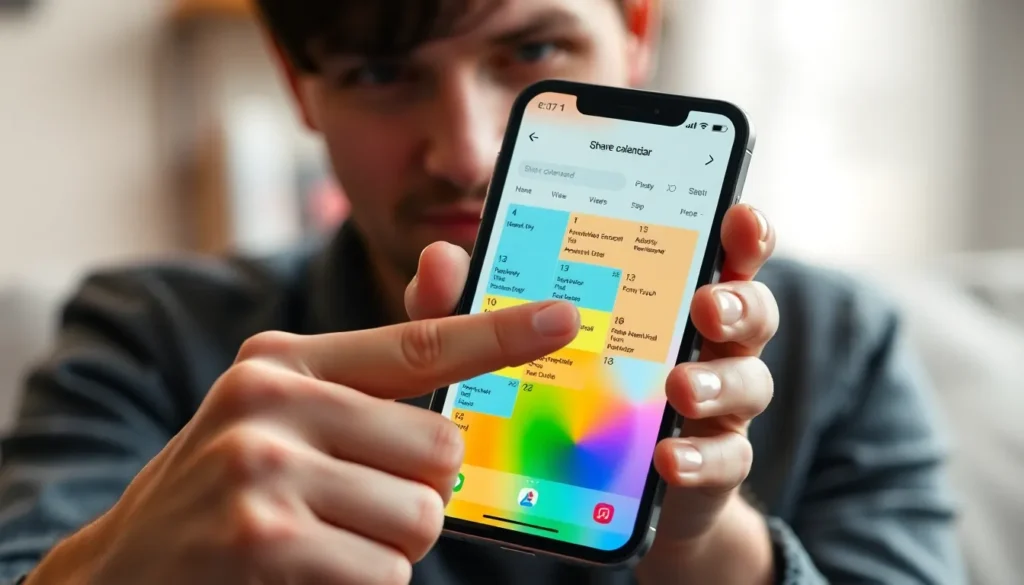In today’s fast-paced world, keeping track of schedules can feel like herding cats. But fear not! Adding a shared calendar on your iPhone is as easy as pie—if pie were a digital tool that helps you coordinate plans without the chaos. Imagine seamlessly syncing schedules with family, friends, or coworkers, all while avoiding the dreaded “I thought we were meeting at 3!” moment.
Table of Contents
ToggleUnderstanding Shared Calendars
Shared calendars provide a collaborative approach to managing schedules. They allow users to add events that everyone involved can view, making it easier to coordinate plans. Events can include appointments, meetings, or social gatherings, ensuring that no one misses important dates.
When creating a shared calendar on an iPhone, users can invite others via email, enabling seamless communication and coordination. It’s especially useful for families planning vacations, groups organizing events, or teams collaborating on projects.
Editing permissions can vary; some users may only view the calendar, while others can add or change events. Flexibility in permissions enhances collaboration, allowing for adaptability based on users’ roles or needs.
Notifications play a crucial role in keeping everyone informed. Users receive alerts when someone adds or modifies an event, ensuring that everyone stays on the same page. Such timely updates help prevent scheduling conflicts and miscommunications.
Integration with other apps amplifies functionality. Calendar applications on an iPhone often sync with email and communication platforms, creating a cohesive, organized experience. Importing events from different sources enhances usability, making shared calendars a comprehensive scheduling tool.
Engagement increases when all parties participate in updating the calendar. Encouraging each member to add their events fosters responsibility and keeps all members accountable. Optimal use of shared calendars transforms time management, facilitating smoother interactions among family members, friends, or coworkers.
Requirements For Adding A Shared Calendar

Shared calendars enhance coordination among family, friends, or coworkers. Certain requirements must be met for effective setup.
Compatible iOS Versions
iOS 13 or later supports shared calendars. Ensure the device runs on these compatible versions for optimal functionality. Users with older iOS versions may encounter limitations or missing features. Upgrading the iOS can enhance user experiences. Device compatibility also extends to iPads and iPod touches running the appropriate iOS.
Necessary Accounts
iCloud accounts play a crucial role in adding shared calendars. Users must sign in with their Apple IDs to access features seamlessly. Google accounts also offer compatibility for calendar sharing on an iPhone. Setting up Exchange accounts allows users to integrate work schedules smoothly. Ensure account settings permit sharing options for optimal collaboration among participants.
Step-By-Step Guide To Add A Shared Calendar
Adding a shared calendar on an iPhone requires only a few straightforward steps. Users can choose to set it up through the Calendar app or the iCloud website.
Using The Calendar App
Open the Calendar app on the iPhone. Tap “Calendars” at the bottom, then select “Add Calendar.” Choose “Add Shared Calendar” and enter the email address of the invitee. Anyone invited receives an email with a link to the shared calendar, allowing them to accept the invitation. Edit permissions by selecting “Change Settings” for each participant, granting options like viewing or editing events. Save the changes, and the calendar updates automatically, keeping everyone informed of new appointments.
Through iCloud Website
Access iCloud.com using a web browser. Sign in with the Apple ID linked to the iPhone, then select the Calendar icon. Click on “Public Calendar” next to the desired calendar to make it shareable. After that, copy the link provided and send it to those you want to include. Participants can view the calendar without an Apple ID. Adjust settings by checking “Show All” or limiting visibility as needed. Syncing occurs automatically, ensuring everyone has real-time updates.
Managing Shared Calendar Settings
Managing shared calendar settings ensures collaboration is efficient and effective. Users can customize who sees and edits calendar events, maximizing the benefit of shared planning.
Editing Permissions
Editing permissions control how participants interact with the shared calendar. Users can set permissions for each individual, allowing them to view or edit events. Options include making a calendar entirely public or restricting access to specific users. Additionally, owners can change permissions later, adapting to changing needs. This flexibility fosters a tailored experience, ensuring everyone involved has the right level of access to facilitate smooth collaboration.
Inviting Additional Users
Inviting additional users to a shared calendar is straightforward. Users can initiate this process directly from the Calendar app by selecting the calendar they wish to share. Adding new participants involves entering their email addresses into the invitation field. Upon sending, recipients receive an email with a link to join the calendar. This enables quick access, even for those without an Apple ID. Once accepted, newly invited users can start viewing events immediately, enhancing group coordination.
Troubleshooting Common Issues
Users may encounter various issues when adding a shared calendar on iPhone. Understanding these common problems helps maintain smooth coordination.
Syncing Problems
Syncing problems can arise, affecting the real-time update of events. Ensure that iCloud settings are enabled on all devices for seamless communication between users. Verify that users are logged into the correct iCloud account; this adds another layer of syncing reliability. Restarting the Calendar app often resolves temporary glitches that hinder synchronization. Users can also check the internet connection, as a weak signal may prevent updates. In some cases, refreshing the calendar by pulling down on the event list can prompt manual syncing, resolving discrepancies quickly.
Access Issues
Access issues frequently occur when users cannot view or edit shared calendars. Confirm that participants accepted the invitation sent via email; access is only granted once invites are accepted. Reviewing permissions is essential; calendar owners can adjust individual access settings to ensure all participants have the appropriate rights. Checking whether the shared calendar is set to private can identify possible restrictions; unchecking this option provides broader visibility. If participants don’t have an Apple ID, make sure they received a shareable link that allows them to view the calendar without an account.
Adding a shared calendar on an iPhone can significantly enhance how individuals manage their time and coordinate with others. By following the outlined steps and utilizing the available features, users can create a collaborative environment that promotes effective scheduling.
With seamless integration and real-time updates, everyone involved stays informed and engaged. The flexibility in permissions allows for tailored access, ensuring that each participant can contribute according to their role.
By embracing this digital tool, families and teams can foster better communication and accountability, leading to smoother interactions and more organized lives. Adopting a shared calendar is a simple yet powerful way to streamline scheduling in today’s fast-paced world.








